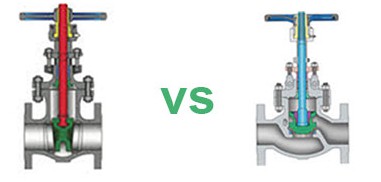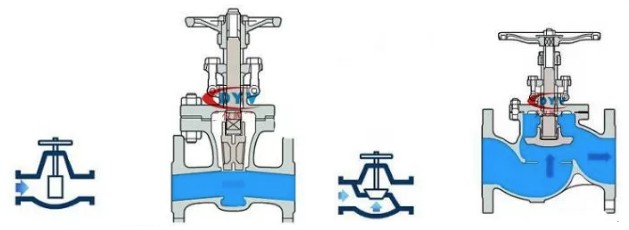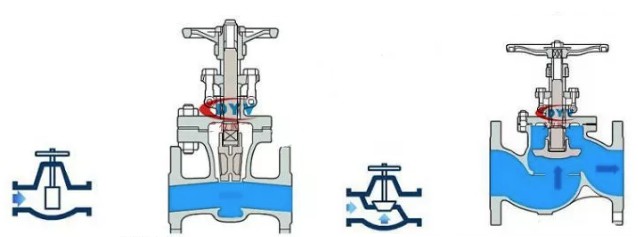What is the difference between globe valve and gate valve
Globe valves, gate valves, butterfly valves, check valves, ball valves, etc. are all indispensable control components in various piping systems. Every valve has a difference in appearance, structure and even functional use. However, the shut-off valve and the gate valve have some similarities in appearance, and both have the function of cutting off in the pipeline, so there will be many valve buyers who do not have much contact with the valve to confuse the two. In fact, if you look closely, the difference between globe valve and gate valve is quite large.

Valve structure
Pay attention to the selection when the installation space is limited. The gate valve can be tightly closed to the sealing surface by the pressure of the medium, so as to achieve the effect of no leakage. When opening and closing, the valve core and the seat sealing surface always contact and rub against each other, so the sealing surface is easy to wear. When the gate valve is close to close, the pressure difference between the front and back of the pipeline is very large, which makes the sealing surface wear more serious.
The structure of the gate valve is more complicated than that of the cut-off valve. From the perspective of the appearance, the gate valve is higher than the cut-off valve, and the cut-off valve is longer than the gate valve. In addition, the gate valve is divided into bright and dark rods. The shut-off valve is not.
working principle
When the shut-off valve is opened and closed, the valve stem is raised, that is, when the hand wheel is turned, the hand wheel will rotate and lift along with the valve stem. The gate valve rotates the hand wheel to make the valve stem move up and down, and the position of the hand wheel does not change. The flow varies, and gate valves require full opening or full closing, while stop valves do not. Shut-off valves have specified inlet and outlet directions; gate valves do not require inlet and outlet directions.
In addition, the gate valve has only two states of fully open or fully closed, and the stroke of the gate opening and closing is large, and the opening and closing time is long. The moving stroke of the valve plate of the shut-off valve is much smaller, and the valve plate of the shut-off valve can be stopped somewhere during the movement for flow adjustment. The gate valve can only be used for cut-off use and has no other functions.

Performance difference
The shut-off valve can be used for both shut-off and flow adjustment. The fluid resistance of the globe valve is relatively large, and it is laborious to open and close, but because the distance between the valve plate and the sealing surface is short, the opening and closing stroke is short.
Because the gate valve can only be fully opened and fully closed, when it is fully opened, the medium flow resistance in the valve body channel is almost 0, so the opening and closing of the gate valve will be very labor-saving, but the distance between the gate and the sealing surface is long, and the opening and closing time is long.
Installation and flow
The gate valve has the same effect in both directions. There is no requirement for the direction of the inlet and outlet, and the medium can flow in both directions. The shut-off valve needs to be installed in strict accordance with the direction indicated by the arrow on the valve body. There is also a clear stipulation on the direction of the inlet and outlet of the shut-off valve.
The shut-off valve is low-in and high-out. When viewed from the outside, it is obvious that the pipeline is not on a phase horizontal line. The gate valve runner is on a horizontal line. The gate valve has a longer stroke than the shut-off valve.
From the perspective of flow resistance, the flow resistance of the gate valve is small and the flow resistance of the load valve is large when it is fully opened. The flow resistance coefficient of the ordinary gate valve is about 0.08 ~ 0.12, the opening and closing force is small, and the medium can flow in two directions. The flow resistance of the ordinary globe valve is 3-5 times that of the gate valve (public name: pump housekeeper). When opening and closing, the valve must be closed forcibly to achieve the seal. The valve core of the shut-off valve only contacts the sealing surface when it is fully closed, so the wear of the sealing surface is very small. Due to the large flow force, the stop valve with an actuator should pay attention to the torque control mechanism. Adjustment.
There are two ways for the shut-off valve during installation. One is that the medium can enter from under the valve core. The advantage is that when the valve is closed, the packing is not under pressure, which can prolong the service life of the packing and can bear the pressure in the pipeline in front of the valve. Under the circumstances, the replacement of packing is performed; the disadvantage is that the driving torque of the valve is large, which is about 1 times of the upper flow, the axial force on the valve stem is large, and the valve stem is easy to bend.
Therefore, this method is generally only applicable to small-diameter globe valves (below DN50), and globe valves above DN200 use the method of medium flowing from above. (The electric shut-off valve generally uses the medium to enter from above.) The disadvantage of the medium to enter from above is exactly the opposite of the way to enter below.

Seal difference
The sealing surface of the globe valve is a small trapezoidal side of the valve core. The gate valve is sealed by the side of the valve disc. The sealing effect is not as good as that of a shut-off valve.
 简体中文
简体中文 Русский
Русский Español
Español Bundor - Butterfly, Gate, Check, Ball, Globe Valve Manufacturer, Supplier & Distributor
Bundor - Butterfly, Gate, Check, Ball, Globe Valve Manufacturer, Supplier & Distributor
